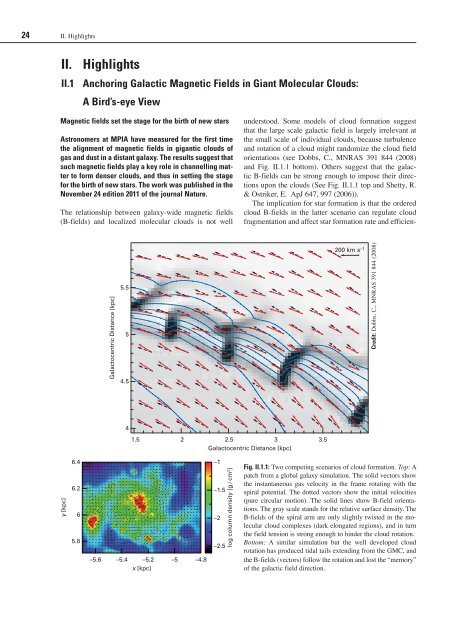Annual Report 2011 Max Planck Institute for Astronomy
Annual Report 2011 Max Planck Institute for Astronomy
Annual Report 2011 Max Planck Institute for Astronomy
You also want an ePaper? Increase the reach of your titles
YUMPU automatically turns print PDFs into web optimized ePapers that Google loves.
24 II. Highlights<br />
II. Highlights<br />
II.1 Anchoring Galactic Magnetic Fields in Giant Molecular Clouds:<br />
A Bird’s-eye View<br />
Magnetic fields set the stage <strong>for</strong> the birth of new stars<br />
Astronomers at MPIA have measured <strong>for</strong> the first time<br />
the alignment of magnetic fields in gigantic clouds of<br />
gas and dust in a distant galaxy. The results suggest that<br />
such magnetic fields play a key role in channelling matter<br />
to <strong>for</strong>m denser clouds, and thus in setting the stage<br />
<strong>for</strong> the birth of new stars. The work was published in the<br />
November 24 edition <strong>2011</strong> of the journal Nature.<br />
The relationship between galaxy-wide magnetic fields<br />
(B-fields) and localized molecular clouds is not well<br />
y [kpc]<br />
6.4<br />
6.2<br />
6<br />
5.8<br />
–5.6<br />
Galactocentric Distance [kpc]<br />
5.5<br />
5<br />
4.5<br />
4<br />
1.5 2<br />
–5.4 –5.2<br />
x [kpc]<br />
–5 –4.8<br />
understood. Some models of cloud <strong>for</strong>mation suggest<br />
that the large scale galactic field is largely irrelevant at<br />
the small scale of individual clouds, because turbulence<br />
and rotation of a cloud might randomize the cloud field<br />
orientations (see Dobbs, C., MNRAS 391 844 (2008)<br />
and Fig. II.1.1 bottom). Others suggest that the galactic<br />
B-fields can be strong enough to impose their directions<br />
upon the clouds (See Fig. II.1.1 top and Shetty, R.<br />
& Ostriker, E. ApJ 647, 997 (2006)).<br />
The implication <strong>for</strong> star <strong>for</strong>mation is that the ordered<br />
cloud B-fields in the latter scenario can regulate cloud<br />
fragmentation and affect star <strong>for</strong>mation rate and efficien-<br />
2.5<br />
3 3.5<br />
Galactocentric Distance [kpc]<br />
–1<br />
–1.5<br />
–2<br />
–2.5<br />
log column density [g / cm 2 ]<br />
200 km s –1<br />
Fig. II.1.1: Two competing scenarios of cloud <strong>for</strong>mation. Top: A<br />
patch from a global galaxy simulation. The solid vectors show<br />
the instantaneous gas velocity in the frame rotating with the<br />
spiral potential. The dotted vectors show the initial velocities<br />
(pure circular motion). The solid lines show B-field orientations.<br />
The gray scale stands <strong>for</strong> the relative surface density. The<br />
B-fields of the spiral arm are only slightly twisted in the molecular<br />
cloud complexes (dark elongated regions), and in turn<br />
the field tension is strong enough to hinder the cloud rotation.<br />
Bottom: A similar simulation but the well developed cloud<br />
rotation has produced tidal tails extending from the GMC, and<br />
the B-fields (vectors) follow the rotation and lost the “memory”<br />
of the galactic field direction.<br />
Credit: Dobbs, C., MNRAS 391 844 (2008)
















